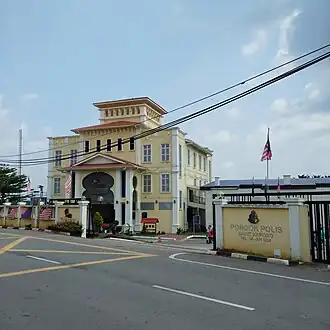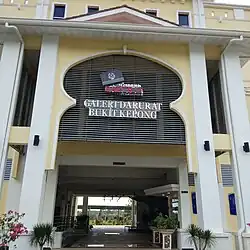Bukit Kepong Emergency Gallery
Galeri Darurat Bukit Kepong | |
 View of Bukit Kepong Emergency Gallery entrance. | |
| Established | February 23, 2017 |
|---|---|
| Location | Muar, Johor, Malaysia |
| Collections | Weapons, lockups, barracks, and excavated artifacts used during the incident |
| Collection size | 815 |
| Architect | Hasa Arkitek Sdn Bhd[1] |
| Owner | Royal Malaysian Police |
Bukit Kepong Emergency Gallery (Malay: Galeri Darurat Bukit Kepong) is a museum located in Muar, Johor, Malaysia. It was built as a memorial to the Bukit Kepong incident that took place during the Malayan Emergency.
History
Bukit Kepong incident
In 1950, an armed conflict occurred between the Federation of Malaya Police and guerilla from the Malayan National Liberation Army (MNLA) in the surrounding area of the remote Bukit Kepong police station. The incident started with a guerrilla assault on the police station by a Communist gunmen which left almost all of the police officers stationed there dead.[2] The policemen refused surrender and held their ground to defend the police station even whist being outnumbered.[3]
Reinforcements from nearby villages
Nearby villages could hear the conflict in Bukit Kepong. Reinforcements from Kampung Tui were made up of villagers escorted by auxillary policemen but were ambushed by the Communists. They were forced to retreat but continue to guard Bukit Kepong's parameters.[4] Their presence eased some pressure on Bukit Kepong and the guerilla forces later retreated after setting ablaze the village office and robbing some stores.
Other reinforcements came from Kampung Durian Chondong who travelled by sampan to provide aid but were also ambushed by Communists forces. Their arrival at 10 a.m was the first instance of the situation in Bukit Kepong being communincated to outsiders.[4]
Aftermath
The conflict ended with the deaths of most of the officers stationed there, some of their family members, 2 civilians and 40 Communist guerilla forces.[2][5]
Design and layout
Architecture

Plans to build the museum were first voiced in 1999.[6] The site of the project was chosen to be at the former location of the police station involved in the Bukit Kepong incident.[7]
Construction of the museum costed RM11.5 million and was separated into three phases.[6] Overall, the gallery has three floors.
The gallery opened on 23 February 2017 during the commemoration of the 67th anniversary of the tragedy. It was officiated by the Sultan of Johor, Sultan Ibrahim. His Majesty was accompanied by the Permaisuri of Johor and their sons. A pantomime was performed during the opening ceremony as a retelling of the incident.[7]
Interior and contents
The gallery compiles and showcases artifacts used by the police force from all over the country during the Malayan Emergency including firearms, vehicles, uniforms and barracks. Historical films about Bukit Kepong are also played within the gallery.[8]
Incidents
In 2022, the Muar district was hit by the worst flood since 2011 at the time. The ground floor of the gallery suffered major floodings due to the overflowing Muar River. Luckily, most artifacts had been moved to higher floors to prevent damage. It was reported that only two armored cars and a boat located outside the gallery were affected.[9] Even so, a total of RM250,000 was provided to restore any artifacts and historical items that were damaged by the floodings.[10]
Use and recognition
An annual commemoration ceremony is held at the gallery since its completion as a memorial to the Bukit Kepong incident.[11] It is held in conjuction with the Police Day celebration in Bukit Kepong.[12]
References
- ^ "Galeri Bukit Kepong – Muar". Archify. Retrieved 7 February 2025.
- ^ a b Driskell, Jonathan; Rutkowski, Marek W.; Ng, Andrew Hock Soon (2025-01-09). The Malayan Emergency in Film, Literature and Art: Cultural Memory as Historical Other. Bloomsbury Publishing. ISBN 978-1-350-41088-6.
- ^ Aziz, Tunku Abdul (2015-06-29). "Remember Bukit Kepong | New Straits Times". NST Online. Retrieved 2025-02-27.
- ^ a b "Bukit Kepong". www.rmp.gov.my (in Malay). Archived from the original on 2020-09-25. Retrieved 2025-02-27.
- ^ Rani, Alias Abd (2025-02-23). "'Komunis tembak perut ayah hingga terburai' - Waris tragedi Bukit Kepong". Berita Harian. Retrieved 2025-02-27.
- ^ a b Noh, Mohamed Farid; Zakaria, Badrul Kamal (2017-02-23). "Galeri Darurat Bukit Kepong satu impian jadi kenyataan". Berita Harian (in Malay). Retrieved 2025-02-05.
- ^ a b Zakaria, Badrul Kamal (2018-12-10). "Jejak kesan sejarah di Bukit Kepong". Berita Harian (in Malay). Retrieved 2025-02-07.
- ^ Ismail, Ahmad (2021-02-23). "Keperwiraan pejuang tragedi Bukit Kepong disanjung tinggi". Harian Metro. Retrieved 2025-02-17.
- ^ AHMAD, FARAHWAHIDA (2022-01-07). "Galeri Darurat Bukit Kepong ditenggelami banjir". Kosmo Digital (in Malay). Retrieved 2025-02-07.
- ^ Johari, Nurayuni (2022-01-14). "RM250,000 diperuntuk baik pulih Galeri Bukit Kepong". MalaysiaGazette (in Malay). Retrieved 2025-02-07.
- ^ Tan, Ben (2018-02-28). "Last survivor of Bukit Kepong incident bemoans fading memory of sacrifice". Malay Mail. Retrieved 2025-02-17.
- ^ Rani, Alias Abd (2025-02-23). "Communists shot my father in the stomach, recalls survivor of Bukit Kepong attack | New Straits Times". NST Online. Retrieved 2025-02-27.